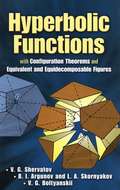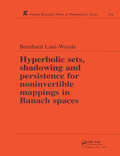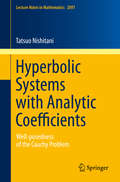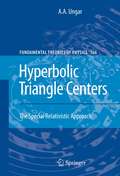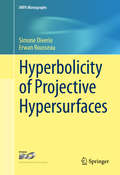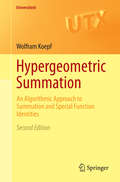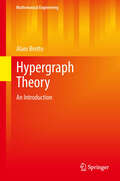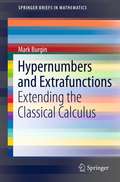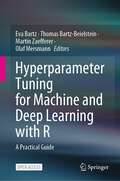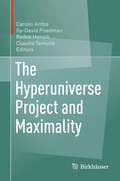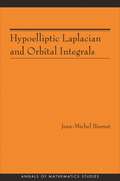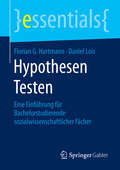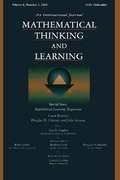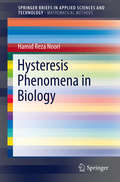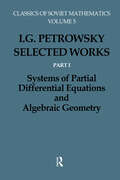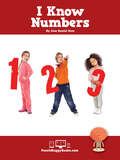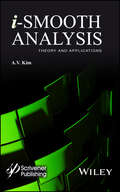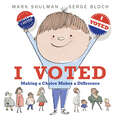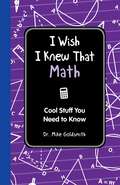- Table View
- List View
Hyperbolic Functions with Configuration Theorems and Equivalent and Equidecomposable Figures
by V. G. Shervatov B. I. Argunov L. A. Skornyakov V. G. BoltyanskiiThis single-volume compilation of three books centers on Hyperbolic Functions, an introduction to the relationship between the hyperbolic sine, cosine, and tangent, and the geometric properties of the hyperbola. The development of the hyperbolic functions, in addition to those of the trigonometric (circular) functions, appears in parallel columns for comparison. A concluding chapter introduces natural logarithms and presents analytic expressions for the hyperbolic functions.The second book, Configuration Theorems, requires only the most elementary background in plane and solid geometry. It discusses several interesting theorems on collinear points and concurrent lines, showing their applications to several practical geometric problems, and thus introducing certain fundamental concepts of projective geometry. Equivalent and Equidecomposable Figures, the final book, discusses the mathematical conditions of dissecting a given polyhedron into a finite number of pieces and reassembling them into another given polyhedron.
Hyperbolic Manifolds
by Albert MardenOver the past three decades there has been a total revolution in the classic branch of mathematics called 3-dimensional topology, namely the discovery that most solid 3-dimensional shapes are hyperbolic 3-manifolds. This book introduces and explains hyperbolic geometry and hyperbolic 3- and 2-dimensional manifolds in the first two chapters and then goes on to develop the subject. The author discusses the profound discoveries of the astonishing features of these 3-manifolds, helping the reader to understand them without going into long, detailed formal proofs. The book is heavily illustrated with pictures, mostly in color, that help explain the manifold properties described in the text. Each chapter ends with a set of exercises and explorations that both challenge the reader to prove assertions made in the text, and suggest further topics to explore that bring additional insight. There is an extensive index and bibliography.
Hyperbolic Sets, Shadowing and Persistence for Noninvertible Mappings in Banach Spaces
by Bernard Lani-WaydaThis text gives a self-contained and detailed treatment of presently known results, and new theorems on hyperbolicity, shadowing, complicated motion, and robustness. The book is intended to provide a dependable reference for researchers wishing to apply such results. This book will be of particular interest to researchers and students interested in dynamical systems, particularly in noninvertible maps and infinite dimensional semi-flows or maps and global analysis.
Hyperbolic Systems with Analytic Coefficients
by Tatsuo NishitaniThis monograph focuses on the well-posedness of the Cauchy problem for linear hyperbolic systems with matrix coefficients. Mainly two questions are discussed: (A) Under which conditions on lower order terms is the Cauchy problem well posed? (B) When is the Cauchy problem well posed for any lower order term? For first order two by two systems with two independent variables with real analytic coefficients, we present complete answers for both (A) and (B). For first order systems with real analytic coefficients we prove general necessary conditions for question (B) in terms of minors of the principal symbols. With regard to sufficient conditions for (B), we introduce hyperbolic systems with nondegenerate characteristics, which contain strictly hyperbolic systems, and prove that the Cauchy problem for hyperbolic systems with nondegenerate characteristics is well posed for any lower order term. We also prove that any hyperbolic system which is close to a hyperbolic system with a nondegenerate characteristic of multiple order has a nondegenerate characteristic of the same order nearby.
Hyperbolic Triangle Centers: The Special Relativistic Approach
by A. A. UngarAfter A. Ungar had introduced vector algebra and Cartesian coordinates into hyperbolic geometry in his earlier books, along with novel applications in Einstein's special theory of relativity, the purpose of his new book is to introduce hyperbolic barycentric coordinates, another important concept to embed Euclidean geometry into hyperbolic geometry. It will be demonstrated that, in full analogy to classical mechanics where barycentric coordinates are related to the Newtonian mass, barycentric coordinates are related to the Einsteinian relativistic mass in hyperbolic geometry. Contrary to general belief, Einstein's relativistic mass hence meshes up extraordinarily well with Minkowski's four-vector formalism of special relativity. In Euclidean geometry, barycentric coordinates can be used to determine various triangle centers. While there are many known Euclidean triangle centers, only few hyperbolic triangle centers are known, and none of the known hyperbolic triangle centers has been determined analytically with respect to its hyperbolic triangle vertices. In his recent research, the author set the ground for investigating hyperbolic triangle centers via hyperbolic barycentric coordinates, and one of the purposes of this book is to initiate a study of hyperbolic triangle centers in full analogy with the rich study of Euclidean triangle centers. Owing to its novelty, the book is aimed at a large audience: it can be enjoyed equally by upper-level undergraduates, graduate students, researchers and academics in geometry, abstract algebra, theoretical physics and astronomy. For a fruitful reading of this book, familiarity with Euclidean geometry is assumed. Mathematical-physicists and theoretical physicists are likely to enjoy the study of Einstein's special relativity in terms of its underlying hyperbolic geometry. Geometers may enjoy the hunt for new hyperbolic triangle centers and, finally, astronomers may use hyperbolic barycentric coordinates in the velocity space of cosmology.
Hyperbolicity of Projective Hypersurfaces
by Simone Diverio Erwan RousseauThisbook presents recent advances on Kobayashi hyperbolicity in complex geometry,especially in connection with projective hypersurfaces. This is a very activefield, not least because of the fascinating relations with complex algebraicand arithmetic geometry. Foundational works of Serge Lang and Paul A. Vojta,among others, resulted in precise conjectures regarding the interplay of theseresearch fields (e. g. existence of Zariski dense entire curves shouldcorrespond to the (potential) density of rational points). Perhapsone of the conjectures which generated most activity in Kobayashi hyperbolicitytheory is the one formed by Kobayashi himself in 1970 which predicts that avery general projective hypersurface of degree large enough does not containany (non-constant) entire curves. Since the seminal work of Green and Griffithsin 1979, later refined by J. -P. Demailly, J. Noguchi, Y. -T. Siu and others, itbecame clear that a possible general strategy to attack this problem was tolook at particular algebraic differential equations (jet differentials) thatevery entire curve must satisfy. This has led to some several spectacularresults. Describing the state of the art around this conjecture is the maingoal of this work.
Hypergeometric Summation
by Wolfram KoepfModern algorithmic techniques for summation, most of which were introduced in the 1990s, are developed here and carefully implemented in the computer algebra system Maple(tm). The algorithms of Fasenmyer, Gosper, Zeilberger, Petkovsek and van Hoeij for hypergeometric summation and recurrence equations, efficient multivariate summation as well as q-analogues of the above algorithms are covered. Similar algorithms concerning differential equations are considered. An equivalent theory of hyperexponential integration due to Almkvist and Zeilberger completes the book. The combination of these results gives orthogonal polynomials and (hypergeometric and q-hypergeometric) special functions a solid algorithmic foundation. Hence, many examples from this very active field are given. The materials covered are suitable for an introductory course on algorithmic summation and will appeal to students and researchers alike.
Hypergraph Theory
by Alain BrettoThis book provides an introduction to hypergraphs, its aim being to overcome the lack of recent manuscripts on this theory. In the literature hypergraphs have many other names such as set systems and families of sets. This work presents the theory of hypergraphs in its most original aspects, while also introducing and assessing the latest concepts on hypergraphs. The variety of topics, their originality and novelty are intended to help readers better understand the hypergraphs in all their diversity in order to perceive their value and power as mathematical tools. This book will be a great asset to upper-level undergraduate and graduate students in computer science and mathematics. It has been the subject of an annual Master's course for many years, making it also ideally suited to Master's students in computer science, mathematics, bioinformatics, engineering, chemistry, and many other fields. It will also benefit scientists, engineers and anyone else who wants to understand hypergraphs theory.
Hypernumbers and Extrafunctions
by Mark Burgin"Hypernumbers and Extrafunctions" presents a rigorous mathematical approach to operate with infinite values. First, concepts of real and complex numbers are expanded to include a new universe of numbers called hypernumbers which includes infinite quantities. This brief extends classical calculus based on real functions by introducing extrafunctions, which generalize not only the concept of a conventional function but also the concept of a distribution. Extrafucntions have been also efficiently used for a rigorous mathematical definition of the Feynman path integral, as well as for solving some problems in probability theory, which is also important for contemporary physics. This book introduces a new theory that includes the theory of distributions as a subtheory, providing more powerful tools for mathematics and its applications. Specifically, it makes it possible to solve PDE for which it is proved that they do not have solutions in distributions. Also illustrated in this text is how this new theory allows the differentiation and integration of any real function. This text can be used for enhancing traditional courses of calculus for undergraduates, as well as for teaching a separate course for graduate students.
Hyperparameter Tuning for Machine and Deep Learning with R: A Practical Guide
by Eva Bartz Thomas Bartz-Beielstein Martin Zaefferer Olaf MersmannThis open access book provides a wealth of hands-on examples that illustrate how hyperparameter tuning can be applied in practice and gives deep insights into the working mechanisms of machine learning (ML) and deep learning (DL) methods. The aim of the book is to equip readers with the ability to achieve better results with significantly less time, costs, effort and resources using the methods described here. The case studies presented in this book can be run on a regular desktop or notebook computer. No high-performance computing facilities are required. The idea for the book originated in a study conducted by Bartz & Bartz GmbH for the Federal Statistical Office of Germany (Destatis). Building on that study, the book is addressed to practitioners in industry as well as researchers, teachers and students in academia. The content focuses on the hyperparameter tuning of ML and DL algorithms, and is divided into two main parts: theory (Part I) and application (Part II). Essential topics covered include: a survey of important model parameters; four parameter tuning studies and one extensive global parameter tuning study; statistical analysis of the performance of ML and DL methods based on severity; and a new, consensus-ranking-based way to aggregate and analyze results from multiple algorithms. The book presents analyses of more than 30 hyperparameters from six relevant ML and DL methods, and provides source code so that users can reproduce the results. Accordingly, it serves as a handbook and textbook alike.
Hyperspace: A Scientific Odyssey Through Parallel Universes, Time Warps, and the Tenth Dimension
by Michio KakuAre there other dimensions beyond our own? Is time travel possible? Can we change the past? Are there gateways to parallel universes? All of us have pondered such questions, but there was a time when scientists dismissed these notions as outlandish speculations. Not any more. Today, they are the focus of the most intense scientific activity in recent memory. In Hyperspace, Michio Kaku offers the first book-length tour of the most exciting (and perhaps most bizarre) work in modern physics. <p><p>The theory of hyperspace (or higher dimensional space)—and its newest wrinkle, superstring theory—stand at the center of this revolution, with adherents in every major research laboratory in the world. Beginning where Hawking's Brief History of Time left off, Kaku paints a vivid portrayal of the breakthroughs now rocking the physics establishment. Why all the excitement? As the author points out, for over half a century, scientists have puzzled over why the basic forces of the cosmos—gravity, electromagnetism, and the strong and weak nuclear forces—require markedly different mathematical descriptions. But if we see these forces as vibrations in a higher dimensional space, their field equations suddenly fit together like pieces in a jigsaw puzzle, perfectly snug, in an elegant, astonishingly simple form. This may thus be our leading candidate for the Theory of Everything.
Hyperspectral Imaging Remote Sensing: Physics, Sensors, and Algorithms
by Dimitris G. Manolakis Ronald B. Lockwood Thomas W. CooleyA practical and self-contained guide to the principles, techniques, models and tools of imaging spectroscopy. Bringing together material from essential physics and digital signal processing, it covers key topics such as sensor design and calibration, atmospheric inversion and model techniques, and processing and exploitation algorithms. Readers will learn how to apply the main algorithms to practical problems, how to choose the best algorithm for a particular application, and how to process and interpret hyperspectral imaging data. A wealth of additional materials accompany the book online, including example projects and data for students, and problem solutions and viewgraphs for instructors. This is an essential text for senior undergraduate and graduate students looking to learn the fundamentals of imaging spectroscopy, and an invaluable reference for scientists and engineers working in the field. A self-contained introductory text covering the principles, techniques, and tools of imaging spectroscopy. Can be used in both undergraduate and graduate settings, and also as a reference text for practitioners. Accompanied online by example projects and data for students, and problem solutions and viewgraphs for instructors.
The Hyperuniverse Project and Maximality
by Carolin Antos Sy-David Friedman Radek Honzik Claudio TernulloThis collection documents the work of the Hyperuniverse Project which is a new approach to set-theoretic truth based on justifiable principles and which leads to the resolution of many questions independent from ZFC. The contributions give an overview of the program, illustrate its mathematical content and implications, and also discuss its philosophical assumptions. It will thus be of wide appeal among mathematicians and philosophers with an interest in the foundations of set theory. The Hyperuniverse Project was supported by the John Templeton Foundation from January 2013 until September 2015
Hypoelliptic Laplacian and Orbital Integrals (Annals of Mathematics Studies #177)
by Jean-Michel BismutThis book uses the hypoelliptic Laplacian to evaluate semisimple orbital integrals in a formalism that unifies index theory and the trace formula. The hypoelliptic Laplacian is a family of operators that is supposed to interpolate between the ordinary Laplacian and the geodesic flow. It is essentially the weighted sum of a harmonic oscillator along the fiber of the tangent bundle, and of the generator of the geodesic flow. In this book, semisimple orbital integrals associated with the heat kernel of the Casimir operator are shown to be invariant under a suitable hypoelliptic deformation, which is constructed using the Dirac operator of Kostant. Their explicit evaluation is obtained by localization on geodesics in the symmetric space, in a formula closely related to the Atiyah-Bott fixed point formulas. Orbital integrals associated with the wave kernel are also computed. Estimates on the hypoelliptic heat kernel play a key role in the proofs, and are obtained by combining analytic, geometric, and probabilistic techniques. Analytic techniques emphasize the wavelike aspects of the hypoelliptic heat kernel, while geometrical considerations are needed to obtain proper control of the hypoelliptic heat kernel, especially in the localization process near the geodesics. Probabilistic techniques are especially relevant, because underlying the hypoelliptic deformation is a deformation of dynamical systems on the symmetric space, which interpolates between Brownian motion and the geodesic flow. The Malliavin calculus is used at critical stages of the proof.
Hypothesen Testen: Eine Einführung für Bachelorstudierende sozialwissenschaftlicher Fächer (essentials)
by Florian G. Hartmann Daniel LoisDie Sozialwissenschaftler Florian G. Hartmann und Daniel Lois erklären in diesem Essential Schritt für Schritt und auf Nachvollziehbarkeit bedacht, wie im Rahmen einer quantitativen Untersuchung Hypothesen überprüft werden. Dabei werden methodische und statistische Grundbegriffe besprochen und komplexere Sachverhalte anhand von alltagsnahen Beispielen erläutert. Die Autoren schöpfen bei den Erklärungen aus ihrer Lehr- und Forschungstätigkeit und berücksichtigen die Erfahrungen ihres eigenen Studiums.
Hypothetical Learning Trajectories: A Special Issue of Mathematical Thinking and Learning
by Douglas H. Clements Julie SaramaThe purpose of this special issue is to present several research perspectives on learning trajectories with the intention of encouraging the broader community to reflect on, better define, adopt, adapt, or challenge the concept. The issue begins by briefly introducing learning trajectories. The remaining articles provide elaboration, examples, and discussion of the construct. They purposefully are intended to be illustrative, exploratory, and provocative with regard to learning trajectories construct; they are not a set of verification studies.
Hysteresis Phenomena in Biology
by Hamid Reza NooriThe occurrence of hysteresis phenomena has been traditionally associated with mechanical and magnetic properties of materials. However, recent studies on the dynamics of biological processes suggest switch-like behavior that could be described by mathematical models of hysteresis. This book presents the milestones and perspectives of biological hysteresis and provides a comprehensive and application-oriented introduction to this subject. The target audience primarily comprises researchers but the book may also be beneficial for graduate students.
I Am So 3!: Look at Everything I Can Do!
by Sandrina KurtzShow your three-year-old all the amazing activities he or she can do! In this adorable picture book, help your child learn all the amazing things that they can do now that they&’re three! Encourage your child to not only do playful activities like paint a picture or throw a ball, but also helpful chores like watering the flowers, feeding their pet, and even putting on their own socks. Your child will learn to see normal household tasks as fun accomplishments to add to their list. With bright illustrations and easy-to-understand language, I Am So 3! will have your child excited about all the things they can do now that they&’re three.
I Can Count to Ten and Back Again
by Linda HaywardWhen Big Bird runs a convenience store, he tries to store things that he thinks his friends would like to buy. Will they buy what he thinks they will like or will they surprise him?
“I Don’t See Color”: Personal and Critical Perspectives on White Privilege
by Bettina Bergo Eula Biss Tracey NichollsWho is white, and why should we care? There was a time when the immigrants of New York City’s Lower East Side—the Irish, the Poles, the Italians, the Russian Jews—were not white, but now “they” are. There was a time when the French-speaking working classes of Quebec were told to “speak white,” that is, to speak English. Whiteness is an allegorical category before it is demographic.This volume gathers together some of the most influential scholars of privilege and marginalization in philosophy, sociology, economics, psychology, literature, and history to examine the idea of whiteness. Drawing from their diverse racial backgrounds and national origins, these scholars weave their theoretical insights into essays critically informed by personal narrative. This approach, known as “braided narrative,” animates the work of award-winning author Eula Biss. Moved by Biss’s fresh and incisive analysis, the editors have assembled some of the most creative voices in this dialogue, coming together across the disciplines. Along with the editors, the contributors are Eduardo Bonilla-Silva, Nyla R. Branscombe, Drucilla Cornell, Lewis R. Gordon, Paget Henry, Ernest-Marie Mbonda, Peggy McIntosh, Mark McMorris, Marilyn Nissim-Sabat, Victor Ray, Lilia Moritz Schwarcz, Louise Seamster, Tracie L. Stewart, George Yancy, and Heidi A. Zetzer.
I.G.Petrovskii:Selected Wrks P
by Olga Oleinik I.G. Petrovskii G.A. YosifanThis book contains the major works of Ivan Georgievich Petrowsky on systems of partial differential equations and algebraic geometry. The articles are of crucial importance for the topology of real algebraic manifolds and are the source of intensive development of theory of real algebraic manifolds.
I Know Numbers
by Lisa Daniel ReesI Know Numbers is a fun informational picture eBook and introduction for kids ages three to seven to learn how to count and recognize numbers found in real life settings. This colorful e-book is a must have for kindergarden and primary school students learning to recognize and count numbers.The non-fiction e-book includes beautiful full color photography and cartoon characters to make learning fun and is great for reference and activities.
i-Smooth Analysis: Theory and Applications
by A. V. KimThe edition introduces a new class of invariant derivatives and shows their relationships with other derivatives, such as the Sobolev generalized derivative and the generalized derivative of the distribution theory. This is a new direction in mathematics. i-Smooth analysis is the branch of functional analysis that considers the theory and applications of the invariant derivatives of functions and functionals. The important direction of i-smooth analysis is the investigation of the relation of invariant derivatives with the Sobolev generalized derivative and the generalized derivative of distribution theory. Until now, i-smooth analysis has been developed mainly to apply to the theory of functional differential equations, and the goal of this book is to present i-smooth analysis as a branch of functional analysis. The notion of the invariant derivative (i-derivative) of nonlinear functionals has been introduced in mathematics, and this in turn developed the corresponding i-smooth calculus of functionals and showed that for linear continuous functionals the invariant derivative coincides with the generalized derivative of the distribution theory. This book intends to introduce this theory to the general mathematics, engineering, and physicist communities.
I Voted: Making a Choice Makes a Difference
by Mark ShulmanAs we approach the 2022 midterm elections, this witty, nonpartisan book will help explain the concept of voting to the youngest readers.I Voted explains the concept of choosing, individually, and as a group, from making a simple choice: "Which do you like better, apples or oranges?", to selecting a class pet, to even more complicated decisions, like electing community representatives. You may not always get want you want, but there are strategies to better your odds! Serge Bloch's effortless and charming illustrations paired with Mark Shulman's funny and timely text create a perfect resource for discussing current events with your children.Backmatter includes information about the United States electoral process.Selected for the CBC Champions of Change ShowcaseA Junior Library Guild SelectionA Bank Street Best Children's Book of the Year!
I Wish I Knew That: Math
by Michael GoldsmithMath, so often a mystery to children, is simply explained in I Wish I Knew That Math. With clear, commonsense explanations of mathematical concepts and fun and interesting applications, this book is a great way to increase your understanding of math. The concepts addressed include, but are certainly not limited to: Basic operations - addition, subtraction, multiplication and division The math behind money The connections between math and music Irrational numbers - Why did Pythagoras have one of his followers killed just for talking about the square root of 2? The value of zero Angles - from acute, all the way to reflexive Coordinates and the Cartesian plane Probability - What is the likelihood of being struck by lightning? Logic - induction, deduction and Sherlock Holmes Computers and algorithms Code breaking - from ancient Rome to super computers With its readable style and engaging examples, I Wish I Knew That: Math can give children a head start or a helping hand in their understanding of math. Even grownups could learn a thing or two that they may have forgotten or maybe things they never learned at all!
